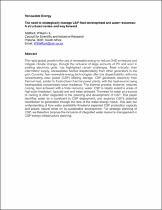 ResearchSpace
ResearchSpace
The need to strategically manage CSP fleet development and water resources: A structured review and way forward
JavaScript is disabled for your browser. Some features of this site may not work without it.
- ResearchSpace
- →
- Research Publications/Outputs
- →
- Journal Articles
- →
- View Item
| dc.contributor.author |
Duvenhage, F

|
|
| dc.contributor.author |
Brent, AC

|
|
| dc.contributor.author |
Stafford, William HL

|
|
| dc.date.accessioned | 2019-08-12T06:57:16Z | |
| dc.date.available | 2019-08-12T06:57:16Z | |
| dc.date.issued | 2019-03 | |
| dc.identifier.citation | Duvenhage F., Brent A.C. & Stafford, W.H.L. 2019. The need to strategically manage CSP fleet development and water resources: A structured review and way forward. Renewable energy, vol. 132, pp. 813-825 | en_US |
| dc.identifier.issn | 0960-1481 | |
| dc.identifier.uri | https://www.sciencedirect.com/science/article/pii/S0960148118309832 | |
| dc.identifier.uri | https://doi.org/10.1016/j.renene.2018.08.033 | |
| dc.identifier.uri | http://hdl.handle.net/10204/11070 | |
| dc.description | Copyright: 2019 Elsevier. This is an abstract. The definitive version of the work is published in Renewable Energy, Vol. 132, pp 813-825 | en_US |
| dc.description.abstract | The rapid global growth in the use of renewable energy to reduce GHG emissions and mitigate climate change, through the inclusion of large amounts of PV and wind in existing electricity grids, has highlighted certain challenges. Most critically, their intermittent supply, necessitates flexible dispatchability from other generators in the grid. Currently, few renewable energy technologies offer this dispatchability, with only concentrating solar power (CSP) offering storage. CSP generates electricity from thermal heat, similar to fossil-driven thermal power plants, with the heat-source being inexhaustible concentrated solar irradiance. The thermal process, however, requires cooling, best achieved with a finite resource; water. CSP is ideally suited to areas of high solar irradiation, typically arid and water stressed. The need for water as a source of cooling is often neglected in the planning and development of CSP. This paper identifies water as a constraint to CSP deployment, and explores CSP's potential contribution to generation through the lens of the water-energy nexus. This aids our understanding of how water availability threatens expected CSP production capacity and places natural limits on its sustainable development. For strategic planning of CSP, we therefore propose the inclusion of integrated water resource management in CSP energy infrastructure planning. | en_US |
| dc.language.iso | en | en_US |
| dc.publisher | Elsevier | en_US |
| dc.relation.ispartofseries | Workflow;21528 | |
| dc.subject | Concentrating solar power | en_US |
| dc.subject | Energy-water nexus | en_US |
| dc.subject | Integrated water resource management | en_US |
| dc.subject | Renewable energy | en_US |
| dc.subject | Sustainable development | en_US |
| dc.subject | Water stress | en_US |
| dc.title | The need to strategically manage CSP fleet development and water resources: A structured review and way forward | en_US |
| dc.type | Article | en_US |
| dc.identifier.apacitation | Duvenhage, F., Brent, A., & Stafford, W. H. (2019). The need to strategically manage CSP fleet development and water resources: A structured review and way forward. http://hdl.handle.net/10204/11070 | en_ZA |
| dc.identifier.chicagocitation | Duvenhage, F, AC Brent, and William HL Stafford "The need to strategically manage CSP fleet development and water resources: A structured review and way forward." (2019) http://hdl.handle.net/10204/11070 | en_ZA |
| dc.identifier.vancouvercitation | Duvenhage F, Brent A, Stafford WH. The need to strategically manage CSP fleet development and water resources: A structured review and way forward. 2019; http://hdl.handle.net/10204/11070. | en_ZA |
| dc.identifier.ris | TY - Article AU - Duvenhage, F AU - Brent, AC AU - Stafford, William HL AB - The rapid global growth in the use of renewable energy to reduce GHG emissions and mitigate climate change, through the inclusion of large amounts of PV and wind in existing electricity grids, has highlighted certain challenges. Most critically, their intermittent supply, necessitates flexible dispatchability from other generators in the grid. Currently, few renewable energy technologies offer this dispatchability, with only concentrating solar power (CSP) offering storage. CSP generates electricity from thermal heat, similar to fossil-driven thermal power plants, with the heat-source being inexhaustible concentrated solar irradiance. The thermal process, however, requires cooling, best achieved with a finite resource; water. CSP is ideally suited to areas of high solar irradiation, typically arid and water stressed. The need for water as a source of cooling is often neglected in the planning and development of CSP. This paper identifies water as a constraint to CSP deployment, and explores CSP's potential contribution to generation through the lens of the water-energy nexus. This aids our understanding of how water availability threatens expected CSP production capacity and places natural limits on its sustainable development. For strategic planning of CSP, we therefore propose the inclusion of integrated water resource management in CSP energy infrastructure planning. DA - 2019-03 DB - ResearchSpace DP - CSIR KW - Concentrating solar power KW - Energy-water nexus KW - Integrated water resource management KW - Renewable energy KW - Sustainable development KW - Water stress LK - https://researchspace.csir.co.za PY - 2019 SM - 0960-1481 T1 - The need to strategically manage CSP fleet development and water resources: A structured review and way forward TI - The need to strategically manage CSP fleet development and water resources: A structured review and way forward UR - http://hdl.handle.net/10204/11070 ER - | en_ZA |





